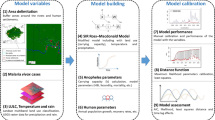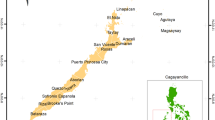Abstract
An epidemic is, in principle, defined as any sudden increase in disease incidence beyond what is considered normal (cf. Najera et al. 1998). Epidemics differ not only in their causality but also in their form of presentation, evolution, incidence by age groups, severity and socio-economic impact (Najera et al. 1992). The epidemics, in the outset, characteristically follow a 2–5 or 7 years’ cycles, recurring in associating with a similar periodicity of abnormal meteorological conditions (heavy rains, floods, draughts, etc.). These abiotic factors actually help in increasing proliferation and survival of vectors such as Anopheles arabiensis, in the desert fringes of Sahara Desert. The higher the favourable temperature and humidity in the desert fringes, the higher is also the transmission rate of malaria and the resultant morbimortality. The impact of epidemics could be minimized through prediction, improved prevention through timely vector control and deployment of appropriate control measures. The implementation of a Malaria Early Warning System may enable regional/national health ministries and/or control managers to focus on epidemiological surveillance and be better prepared to take necessary actions.
Access this chapter
Tax calculation will be finalised at checkout
Purchases are for personal use only
Similar content being viewed by others
References
Anonymous (2002a) Bees zeeley malaria ki chapet mein [Twenty districts under the impact of malaria]. Dainik Bhaskar 239(1):10. (in Hindi)
Anonymous (2002b) Sanbhag mein unnees lakh llogoan ko malaria ka khatra. [Malaria risk to nineteen lakhs people in (Jodhpur) region]. Dainik Bhaskar 240:15. (in Hindi)
Anonymous (2019) Anopheles stephensi. Invasive species compendium (ISC). CABI (Centre for Agriculture and Bioscience International). 2019-11-20. Retrieved 2022-01-22
Anonymous (2020) U.S. President’s Malaria Initiative in Niger. Malaria Operational Plan FY 2020
Bartholomew JG, Herbertson AJ (1899) Bartholomew’s physical atlas: an atlas of meteorology, vol III. The Royal Geographical Society, Edinburgh
Bose A (2004) Malaria Deaths in Rajasthan Desert. Econ Polit Wkly 39(25):2557–2559
Bouma MJ, Van Der Kaay HJ (1995) Epidemic malaria in India’s Thar Desert. Lancet 373:132–133
Bouma MJ, van der Kaay HJ (1996) The El Nino Southern Oscillation and the historic malaria epidemics in the Indian sub-Continent and Sri Lanka: an early warning system for future epidemics. Trop Med Int Health 1:86–96
Bouma MJ, Sondorp HE, van der Kaay HJ (1994a) Health and climate change. Lancet 343:302
Bouma MJ, Sondorp HE, van der Kaay HJ (1994b) Climate change and periodic malaria. Lancet 343:1440
EPHI (Ethiopian Public Health Institute) (2016) Ethiopia National Malaria Indicator Survey 2015. Ethiopian Public Health Institute, Addis Ababa. https://www.ephi.gov.et/images/pictures/download2009/MIS-2015-Final-Report-December-_2016.pdf. Accessed 30 June 2017
Ermert V, Fink AH, Jones AE, Morse AP (2011a) A new version of the Liverpool Malaria Model. I. Review of the parameter setting and model structures. Malar J. https://doi.org/10.1186/1475-2875-10-35
Gerensea H, Teklay H (2017) Pattern and trend of malaria morbidity and mortality in Tigray Region, Ethiopia from 2011/12–2014/15. J Bioanal Biomed 9(2):114–117
Gill CA (1921) The role of meteorology in malaria. Indian J Med Res 8:633–693
Gill CA (1923) The prediction of malaria epidemics. Indian J Med Res 10:1136–1143
Hay SI, Guerra CA, Tatem AJ, Atkinson PM, Snow RW (2005) Urbanization, malaria transmission, and disease burden in Africa. Nat Rev Microbiol 3:81–90
Hoshen MB, Morse AP (2004) A weather-driven model of malaria transmission. Malar J 3:32. https://doi.org/10.1186/1475-2875-3-32
IvyPanda (2022) The epidemiology of human malaria in Africa. https://ivypanda.com/essays/analytical-epidemiological-literature-review-malaria-an-epidemic-in-africa/
Jain R (1994) Mosquitoes storm the desert: a cerebral malaria epidemics in Rajasthan has its source in the Indra Gandhi Canal. Down To Earth, Nov. 30, pp 5–7
Jones AE, Morse AP (2010) Application and validation of a seasonal ensemble prediction system using a dynamic malaria model. J Climate 23:4202–4215
Laneri K, Bhadra A, Ionides EL, Bouma M, Dhiman RC et al (2010) Forcing versus feedback: epidemic malaria and monsoon rains in Northwest India. PLoS Comput Biol 6(9):e1000898. https://doi.org/10.1371/journal.pcbi.1000898
Lindsay SW, Martens WJM (1998) Malaria in the African highlands: past, present and future. Bull World Health Org 76(1):33–45
Mathur KK, Harpalani G, Kalra NL, Murthy GG, Narasimham MV (1992) Epidemic of malaria in Barmer district (Thar desert) of Rajasthan during 1990. Indian J Malariol 29(1):1–10
Mukhopadhyay S, Tiwari R, Shetty P, Gogtay NJ, Thatte UM (2019) Modeling and forecasting Indian malaria incidence using generalized time series models. Commun Stat Case Stud Data Anal Appl 5(2):111–120. https://doi.org/10.1080/23737484.2019.1580629
Najera E, Liese BH, Hammer J (1992) Malaria, new patterns and perspectives. World Bank Technical Paper No. 183
Najera JA, Kouznetzsov RL, Delacollette C (1998) Malaria epidemics : detection and control; forecasting and prevention. WHO/MAL/98. 1084, 81 pp
Protopopoff N, Van Bortel W, Speybroeck N, Van Geertruyden J-P, Baza D, D’Alessandro U, Coosemans M (2009) Ranking malaria risk factors to guide malaria control efforts in African highlands. PLoS One 4(11):e8022. https://doi.org/10.1371/journal.pone.0008022
Roy M, Bouma M, Dhiman RC, Pascual M (2015) Predictability of epidemic malaria under non-stationary conditions with process-based models combining epidemiological updates and climate variability. Malar J 14:419. https://doi.org/10.1186/s12936-015-0937-3
Sarkar S, Gangare V, Singh P, Dhiman RC (2019) Shift in potential malaria transmission areas in India, using the fuzzy-based climate suitability malaria transmission (FCSMT) model under changing climatic conditions. Int J Environ Res Public Health 16(18):3474. https://doi.org/10.3390/ijerph16183474
Sharma R, Jagdev DK, Gehlot GS, Kothari K, Gupta SD, Jain TP, Kothari D (1995) Expert committee on malaria: report. Medical & Health Department, Government of Rajasthan, Jaipur, p 132
Shukla RP, Pandey AC, Mathur A (1995) Investigation of malaria outbreak in Rajasthan. Indian J Malariol 32(3):119–128
Smith DL, Dushoff J, Snow RW, Hay SI (2005) The entomological inoculation rate and Plasmodium falciparum infection in African children. Nature 438(7067):492–495. https://doi.org/10.1038/nature04024
Tesfay K, Assefa B, Addisu A (2019) Malaria outbreak investigation in Tanquae, Abergelle district, Tigray region of Ethiopia: a case–control study. BMC Res Notes 12:645. https://doi.org/10.1186/s13104-019-4680-7
Tewari DD, Braimoh LA, Bokana KG (2009) Factors affecting malaria epidemics and its economic impacts on households in Ajegunle, Lagos State, Nigeria. J Interdiscip Econ 21(1):79–96. https://doi.org/10.1177/02601079X09002100107
Tyagi BK (1994b) Impact of extensive canalization on the distribution of malaria vectors in the north-western Rajasthan. Abstr. pap. Indian sci. cong. assoc., Jaipur, pp 39–40
Tyagi BK (1996f) Malaria in the Thar Desert: a bird’s eye-view. Abstr. poster 63rd ann. meet Indian acad sci, Jodhpur
Tyagi BK (1998a) Malaria and its vectors in the Thar Desert, northwestern Rajasthan (India). In: Goel SC, Sharma SK, Malhotra PR, Tandon N, Tyagi BK (eds) Advances in medical entomology & human welfare. The Uttar Pradesh Zoological Society, Muzaffarnagar, India, pp 1–10
Tyagi BK (2001a) Malaria conflagration under the impact of changing Thar Desert environment (north-western Rajasthan, India). In: Symposium on the impact of human activities on Thar Desert environment, CAZRI, Jodhpur, p. 109
Tyagi BK (2001b) Major vector-borne human diseases in the Thar Desert, with special reference to the changing climate. In: Verma SK, Nahar NM, Raj-Bhansali R, Jindal SK, Satya Vir (eds) Priorities of research for development of arid regions. Scientific Publishers, Jodhpur, India, pp 103–112
Tyagi BK (2002) Malaria in the Thar Desert: facts, figures and future. Agrobios (India), 162 pp
Tyagi BK (2003a) Malaria conflagration under the impact of changing Thar Desert environment. In: Narayanan P, Kathju S, Kar A, Singh MP, Praveen Kumar (eds) Human impact on Desert environment. Arid Zone Research Association of India & Scientific Publishers (India), Jodhpur, pp 60–73
Tyagi BK (2004a) A review of the emergence of Plasmodium falciparum dominated malaria in irrigated areas of the Thar Desert, India. Acta Trop (Special Issue: Malaria & Agriculture) 89:227–239. https://doi.org/10.1016/j.actatropica.2003.09.016
Tyagi BK (2004b) The invincible deadly mosquitoes. Scientific Publishers, Jodhpur, India, p 265
Tyagi BK, Chaudhary RC (1997) Outbreak of falciparum malaria in the Thar Desert with particular emphasis on physiographic changes brought about by extensive canalization and their impact on vector density and dissemination. J Arid Env 36:541–555
Tyagi BK, Yadav SP (1996c) Correlation of irrigation and flood water management with malaria in the Thai desert. WHOSEARO Reg Health Forum 2:5–11
Tyagi BK, Yadav SP (2001a) Bionomics of malaria vectors in two physiographically different areas of the epidemic-prone Thar Desert, north-western Rajasthan (India). J Arid Environ 47:161–172
Tyagi BK, Yadav SP (2001b) Evolution of pathways of vectorism and malaria epidemics in the Thar Desert, northwestern India. Abstr pap 15th national congress of parasitology, Jodhpur, pp 71–72
Tyagi BK, Singh KV, Bansal SK, Yadav SP (1994) Malaria epidemic in some villages of north-western desert Rajasthan. J App Zool Res 5:152–155
Tyagi BK, Chaudhary RC, Yadav SP (1995) Epidemic malaria in Thar Desert, India. Lancet 346:634–635
Tyagi BK, Yadav SP, Sachdev R, Dam PK (2001a) Malaria outbreak in the IGNP command area in Jaisalmer district, Thar Desert, India. J Commun Dis 33(2):88–95
Tyagi BK, Singh KV, Bansal SK, Yadav SP, Dam PK (2001b) Thar Marukschetra mein malaria ka prakop wa uska nidaan [Malaria conflagration in the Thar Desert region and its control]. Abstr pap symp Vgyan Pradyogiki Ke Naye Aayaam, Jodhpur, pp 66–69 (in Hindi)
WHO (2008) World health statistics 2008. World Health Organization, Geneva
WHO (2009) World malaria report 2009. World Health Organization, Geneva. http://whqlibdoc.who.int/publications/2009/9789241563901_eng.pdf. Accessed 30 Mar 2010
WHO (2019a) World malaria report 2019. World Health Organization, Geneva
WHO (2019b) Vector alert: Anopheles stephensi invasion and spread. https://www.who.int/news-room/detail/26-08-2019-vector-alert-anopheles-stephensi-invasion-and-spread
WHO (2019c) Vector alert: Anopheles stephensi invasion and spread—horn of Africa, the Republic of the Sudan and surrounding geographical areas and Sri Lanka. Information Note
Zhou G, Minakawa N, Githeko AK, Yan G (2004) Association between climate variability and malaria epidemics in the East African highlands. Proc Natl Acad Sci U S A 101:2375–2380
Author information
Authors and Affiliations
Rights and permissions
Copyright information
© 2023 The Author(s), under exclusive license to Springer Nature Singapore Pte Ltd.
About this chapter
Cite this chapter
Tyagi, B.K. (2023). Epidemics of Malaria in Major Deserts. In: Desert Malaria. Springer, Singapore. https://doi.org/10.1007/978-981-19-7693-3_13
Download citation
DOI: https://doi.org/10.1007/978-981-19-7693-3_13
Published:
Publisher Name: Springer, Singapore
Print ISBN: 978-981-19-7692-6
Online ISBN: 978-981-19-7693-3
eBook Packages: Biomedical and Life SciencesBiomedical and Life Sciences (R0)




